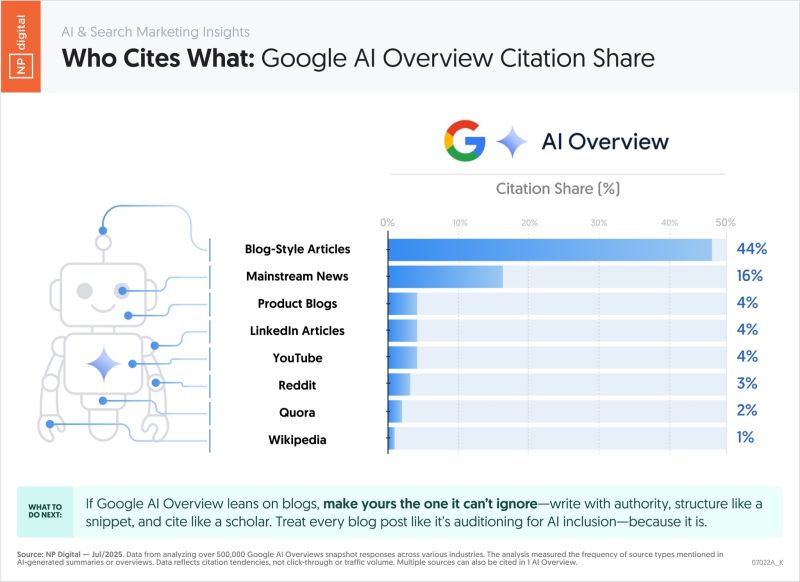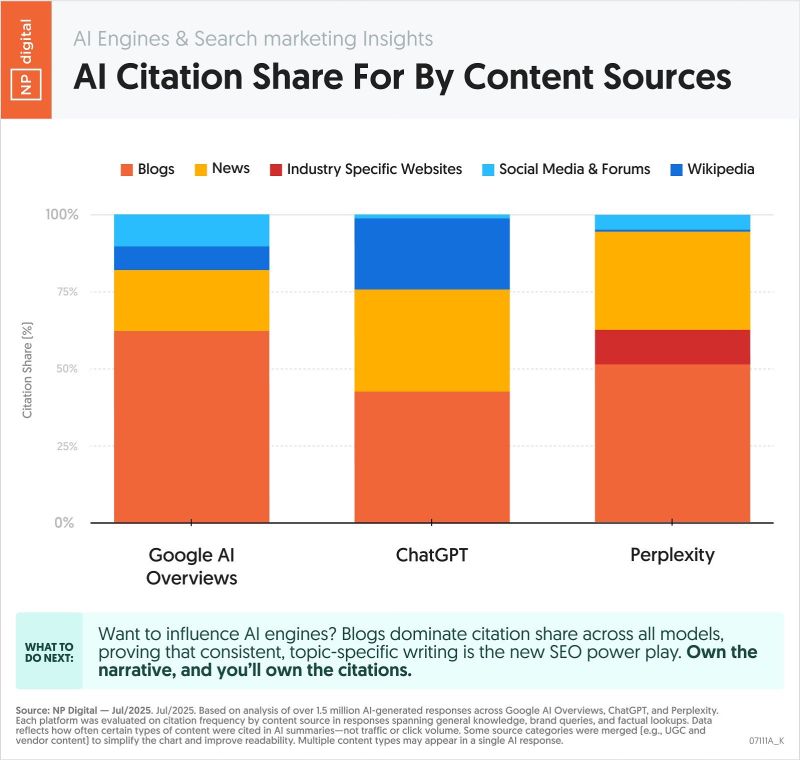AERPOWER Blog
We really, really love what we do.
If you want long-term visibility and digital credibility in aviation, aerospace and defense, your blog may be your most valuable—and most overlooked—asset.
Not just for SEO. Not just for brand awareness. But because it builds authority—for humans and for machines.
New research from Neil Patel’s team at NP Digital analyzed over 1.5 million AI-generated responses across platforms like Google AI Overviews, ChatGPT, and Perplexity. And the data reveals a clear trend in how visibility is earned—which we’ll break down below.
When Neil Patel’s team at NP Digital analyzed over 1.5 million AI-generated results across Google AI Overviews, ChatGPT, and Perplexity, they uncovered a clear pattern:
Blogs consistently lead citation share across platforms:
These aren’t subtle differences. They’re systemic.
AI tools don’t just recognize blog content—they rely on it.
And in industries like aviation and defense—where technical clarity, credibility, and trust-building over time are non-negotiable—that’s not just interesting.
It’s strategic.
???? Source: See the original data visualizations from Neil Patel:



In aviation and defense, your blog isn’t just content—it’s a credibility engine. Buyers do deep research long before they engage. And increasingly, AI tools are doing that research alongside them.
To build trust with both, your blog needs to go beyond updates and press releases. It should teach, clarify, and remove friction from the buying process.
Here’s what that looks like:
Blog Topics That Build Trust — and Why They Work
1. Explain the Full Process
Walk the reader through how something actually works—before and after the sale.
Examples:
• “Certifying to RTCA/DO-160G: A Step-by-Step Breakdown”
• “What Maintenance Looks Like After 10,000 Flight Hours”
Why it works: It removes uncertainty. Technical buyers want to know what they’re really signing up for. Detailing the process signals preparedness and experience.
2. Debunk Misconceptions or Buyer Hesitations
Tackle doubts head-on and explain where your offering fits—and where it doesn’t.
Examples:
• “Do I Need to Replace the Whole System? (Usually, No)”
• “Can You Really Trust Resonance Testing? Here’s the Science”
Why it works: Buyers are skeptical. Addressing objections upfront builds trust faster than promises ever could.
3. Clarify Delivery Timelines and Transitions
Talk openly about delivery, onboarding, and post-purchase realities.
Examples:
• “From PO to Deployment: What to Expect”
• “Lead Times, Logistics, and Lessons Learned”
Why it works: A&D buyers hate surprises. Clarity—even if your lead time is long—builds confidence and trust.
4. Teach Something They Can Use
Offer insights that make their jobs easier or more informed—even if it doesn’t lead directly to a sale.
Examples:
• “7 Compliance Changes Aerospace Suppliers Should Prepare for in 2026”
• “What NDT Leaders Need to Know About AI-Driven Inspection”
Why it works: When your blog helps the reader succeed, they start seeing you as a resource—not just a vendor.
5. Share Real-World Support or Success Stories
Use short anecdotes or examples to demonstrate responsiveness and reliability.
Examples:
• “The Call We Got at Midnight—and What We Did Next”
• “How We Helped a Supplier Hit a 3-Day Turnaround”
Why it works: Stories build trust faster than case study PDFs. They show what your team is like in real-world conditions.
6. Show How You Fit Into the Buyer’s Ecosystem
Explain how your solution works within existing systems, specs, or supply chains.
Examples:
• “How Our Connector Interfaces with MIL-STD-1553 Systems”
• “Supporting Tier 1s in the JSF Supply Chain”
Why it works: A&D buyers rarely buy in isolation. Showing how you fit into the bigger picture removes integration anxiety.
???? What to Avoid
Avoid blog content that:
• Says little and teaches nothing
• Is written only to fill space or “check the box”
• Is too vague, too self-promotional, or too jargon-filled
Examples:
• Press releases labeled as blog posts
• Company news with no external relevance
• “Fluff” content with no clear takeaway or structure
Bottom Line
Aerospace blogs work best when they’re useful.
Useful content earns trust. Trusted content gets shared, cited, and surfaced—by buyers and by AI.
???? Pro Tip:
Ask your sales or BD team what questions they hear most often from prospects.
If a question comes up in meetings, on calls, or during proposals—it’s probably a perfect blog topic. If it helps them close deals, it can help someone find you in the first place.
To rank in Google, surface in AI-driven previews, and build trust with technical audiences, your blog needs to serve both human buyers and machine readers. That means structure, clarity, and intent aren’t optional—they’re the foundation.
Here’s how to structure a blog that earns visibility and trust:
1. Clear, Keyword-Driven Title
Use specific, benefit-focused language—not clever wordplay.
Lead with clarity and place the primary keyword early.
Examples:
• “How Aerospace Teams Use Thermal Imaging to Spot Stress Cracks”
• “What Engineers Need to Know About Non-Destructive Testing in 2025”
Why it works: Readers and AI models quickly understand what the content covers—and why it matters.
2. Engaging Introduction (Problem + Purpose)
Open with:
• A real-world problem your audience faces
• Why it’s relevant right now
• What the blog will deliver
???? Pro tip: Use a short anecdote, stat, or technical tension to hook the reader—but stay grounded in clarity.
3. Subheadings That Organize the Content
Break the blog into 2–5 clear, skimmable sections.
Each subhead should help the reader (or AI tool) navigate the content easily.
Use cases:
• “Why Your Compliance Process is Slower Than It Should Be”
• “3 Ways to Reduce Downtime During Aircraft Inspection”
Short paragraphs (2–4 sentences) and bullets are essential. Use bold to highlight key takeaways or definitions.
4. Use Visuals with a Purpose
Add:
• Diagrams or test results
• Workflow graphics or dashboards
• Charts that explain timelines or metrics
Include descriptive captions and alt-text that support your SEO keywords.
Bonus: If you’re referencing research (e.g., Sprout Social or NP Digital), summarize the insight and show the chart.
5. Link with Intention
• Internal Links: Connect to pillar pages (e.g., “Aircraft Systems Integration”) or relevant past blogs.
• External Links: Cite only trusted, non-competing sources (e.g., FAA, NASA, IEEE, NDIA).
Why it works: Links help both the reader and the algorithm understand how your content fits into the larger picture.
6. End with a Useful, Trust-Building CTA
Make it clear what the reader should do next—without being pushy.
Examples:
• “Download our Guide to Modernizing Aircraft Maintenance Documentation.”
• “Explore our solution library for structural testing challenges.”
• “Want a second set of eyes on your system spec? Let’s talk.”
Pro tip: Keep CTAs buyer-relevant—not just lead-gen focused.
7. Optional Enhancements (for AI + Authority)
• Add a short FAQ at the bottom (helps with Featured Snippets + AI Overviews)
• Include a byline or SME signature with a brief credential tag
• Pull in customer use cases or real-world references
• Optimize meta description and slug if possible
Aviation Blog Cheat Sheet

Your blog should be your most strategic content asset—not just a parking spot for company news.
As a real-world example, our blog “Demystifying the Role of Marketing in Aerospace and Defense Companies” continues to attract sustained traffic. It doesn’t sell. It educates—and it reflects how our buyers think and what they want to understand.
So if your blog has been collecting dust, it’s time to wake it up.
Start by:
– Blogging once per month with purpose
– Aligning posts to high-level pillar content
– Writing for buyers and SMEs—not just algorithms
Because in the eyes of AI and your customer, clarity builds credibility. And blogs still lead the way.
Curious where your blog stands? We help A&D brands audit and structure content that earns attention—from buyers and bots. Reach out to start a smarter blogging strategy.
————————-
Sarah Stanczyk is the Digital Marketing Director at AERPOWER Aviation Marketing, a strategic partner to aerospace and defense companies navigating complex, long-cycle sales. With 12+ years of experience in B2B and technical markets, she helps brands clarify their positioning, amplify their visibility, and align marketing with how real buyers evaluate and decide.